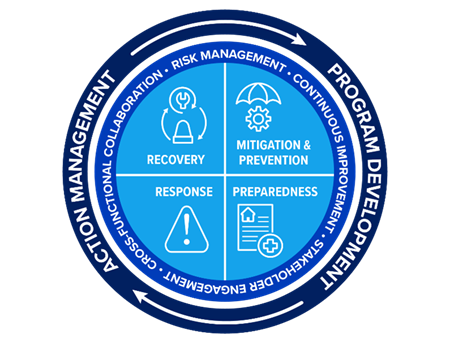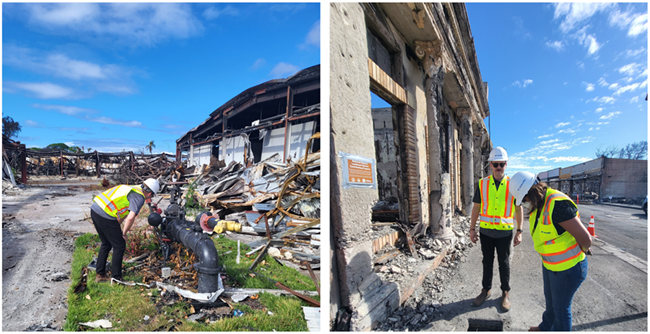Emergency Management in the Water Sector: Engineering Resilience
By: Shawn Corrigan, Resilience & Sustainability Practice Director, Carollo Engineers
As an emergency manager working closely with engineers in the water and wastewater sector, I have witnessed firsthand the critical role that engineering expertise plays in building resilience and maintaining operational continuity during crises. Whether designing solutions to safeguard infrastructure, applying advanced technologies, or collaborating across disciplines, engineers provide essential insight and innovative approaches that strengthen emergency management frameworks.
I have always found great satisfaction in working alongside engineers. Their ability to translate technical challenges into actionable solutions inspires confidence in our shared mission to protect communities. In this blog, I will share insights into how engineering supports emergency management in the water sector. These contributions emphasize the importance of collaboration, community engagement, and advanced technologies in safeguarding water infrastructure and the people who depend on it.
The Role of Engineering in Emergency Management
Engineering is at the core of building resilient water infrastructure capable of withstanding and recovering from disasters. Beyond designing and implementing physical systems, engineers lead the implementation of risk and resilience strategies needed for operational continuity.
The cycle of emergency management includes four critical phases:
- Mitigation and Prevention
Engineers assess vulnerabilities and develop solutions to mitigate risks. For example, integrating flood protection measures, adopting low-carbon construction materials, and incorporating renewable energy systems contribute to resilient and sustainable systems, and can reduce the likelihood and impact of disasters. - Preparedness
Emergency preparedness includes developing response plans, conducting simulation-based exercises, and confirming system readiness. Technologies like Geographic Information Systems (GIS) and remote sensors help utilities visualize risks, evaluate scenarios, and allocate resources effectively. - Response
During emergencies, engineering teams provide critical expertise to maintain essential services, deploy temporary solutions, and restore functionality. Crisis decision-making can be supported by remote monitoring and advanced data analysis tools. - Recovery
Recovery efforts focus engineers on assessing damage, rebuilding infrastructure, and becoming more resilient. This phase provides an opportunity to identify and incorporate lessons, innovate, and reduce vulnerabilities to future risks.

Engineering Contributions to Response and Recovery
Engineers play a vital role in responding to and recovering from disasters. High-profile events such as the 2023 Lahaina wildfires in Maui and the devastating wildfires in California over recent years highlight the critical contributions of engineers in restoring essential services, assessing damage, and building resilience. In the Lahaina wildfires, engineers collaborated with the Maui Department of Water Supply to assess above-grade water assets, including fire hydrants, meter assemblies, and service laterals. Methodologies were developed to address the thermal, mechanical, and chemical damage caused by intense heat and toxic emissions. Asset management frameworks were leveraged to create tailored practices for assessing and categorizing damage, providing reporting to support restoration efforts.

Engineers from Carollo assess the damage following the 2023 Lahaina wildfires
Protecting critical water system components, such as pipelines, reservoirs, and pump stations is another key focus. For instance, in Lahaina, engineers evaluated various restoration approaches, including sampling service laterals, capping damaged laterals, and employing representative sampling. These measures facilitated a phased restoration of service. The hazardous conditions in wildfire-affected areas require rigorous safety protocols. Engineers working on the Lahaina fires worked under challenging circumstances, addressing risks with safety plans. These included site inspections, personal protective equipment, and risk management practices. Additionally, psychological first aid and mental health support were integrated to prioritize the safety and well-being of field staff. Digital tools have also played a transformative role in wildfire recovery efforts. GIS mapping was used in Lahaina to document asset conditions and monitor restoration progress. These tools help to compile actionable data and support better decision-making. Collaboration was also key. In Lahaina, engineers coordinated with county, state, and federal agencies to complete damage assessments and recovery activities. This collaborative approach helps with resource allocation and effective resilience strategies.
Enhancing Resilience Through Collaboration and Technology
Engineers are essential to building resilience in the water sector, combining technical expertise with collaboration and innovation to protect infrastructure and support communities during emergencies. They work closely with utility managers, community leaders, and policymakers to align resilience strategies with local priorities and use tools to anticipate and respond to crises. Community engagement is key, as engineers identify vulnerabilities like flood-prone areas or fire risks and design adaptive infrastructure to address them. This collaboration fosters public trust and promotes equitable access to safe water and infrastructure.
Advanced technologies such as GIS and remote sensing are critical tools in emergency management. GIS helps map vulnerabilities, monitor infrastructure in real-time, and prioritize actions. These tools enable a more efficient recovery and minimize service disruptions to the extent possible. During events like the Lahaina wildfires, engineers led teams to assess damage, create recovery plans, and restore services, demonstrating their ability to coordinate complex, multi-agency emergency management efforts effectively.
By combining technical knowledge with proactive planning, engineers create robust systems that withstand and recover from disasters. Their leadership and innovation make water systems more reliable, adaptable, and resilient in the face of growing environmental and societal challenges.
Building a Resilient Future Through Engineering Leadership
As the impact and complexity of challenges in the water sector continue to grow, the role of engineers in emergency management becomes increasingly clear. Throughout my career, I have benefited from and enjoyed collaborating with engineers. Their expertise has been key to addressing complex emergencies. Their ability to design resilient systems, leverage advanced technologies, and foster cross-sector collaboration is essential for protecting critical infrastructure and ensuring communities can withstand and recover from disasters. Engineers translate technical complexity into actionable solutions, enabling utilities to address their vulnerabilities, adapt to changing conditions, and build stronger systems.
Looking ahead, there is significant potential to further expand the capacity of engineers to contribute to all phases of the emergency management cycle; mitigation, preparedness, response, and recovery. By creating opportunities for collaboration across disciplines, the water sector can continue to innovate and strengthen its resilience strategies.
Resilience is not a one-time achievement, it is an ongoing process that requires innovation, planning, and a commitment to collaboration. By integrating engineering insight with the principles of resilience and sustainability, utilities can help to prepare for future challenges while addressing the needs of today. I invite you to take the next step by exploring opportunities within your organization to foster stronger partnerships between engineers, emergency managers, and responders. By working together, we can advance the role of engineers in emergency management and build a water sector that is adaptive, reliable, and equipped to protect resources and serve our communities.